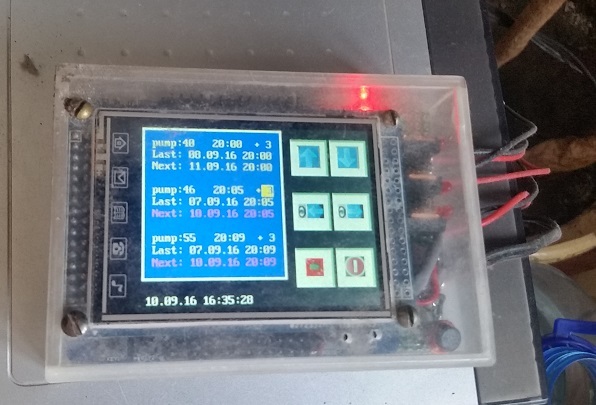Scheduled Watering (STM32F103)
Having looked at the fact that Geektimes are laying out descriptions of Chinese “watering plants” of indoor plants, I decided to share my experience. Let it be a bit late (I have been working with watering for 2.5 years).
I do not belong to lovers of indoor flora who carefully monitor the flowers, carefully wipe the leaves, etc. But I have nothing against the plants themselves. Somehow, throwing another dead plant, I thought that it was already too much. And, since it was dried scarlet (!), Then the search was squared.
Having looked at what is on the e-bay and in the stores, I decided (for various reasons) that it’s easier to do it yourself from the overwhelmed board with an LCD touch screen.

On e-bay, this module usually appears under the name “Mini STM32 STM32F103RBT6 Development Board w / 2.8" TFT LCD Touch Screen. ”
The number“ three ”for the number of independent channels was selected after evaluating the types of plants, and in which heaps they can be combined for irrigation according to one schedule.
In fact, it turned out a timer with power keys for three channels with programmed control.
It all took three nights, because the program itself is simple, assembled from ready-made developments from my earlier projects. Assembling MOSFET power keys on a piece of the breadboard didn’t take much time Poleviks
(IRF3205) do not need radiators, since the on / off mode does not imply more losses, and when open, the resistance of these transistors is scanty.
The body panels were cut on a home CNC machine and glued with dichloroethane.
As a power supply, we took a 12V power supply from an ancient and long-dead netbook.
For direct watering, washer motors with tanks in the kit were purchased. The wiring to the pots is the glass washer tubes with nozzles from it. Purchased the cheapest option that was found in the car shop.
Initially, the idea was to add soil moisture sensors, etc. But the operating experience showed that the flowers that survived had enough watering on schedule. For two and a half years there were no more victims, with minor exceptions (the orchid died ...).
It is necessary to add water to the tanks once every 3 weeks and once every 2-3 months to clean them of plaque and other things. It is a pity that in the water for flowers (as in the spindle cooling circuit on the CNC machine), coolant concentrate cannot be added. Otherwise, tanks would not have to be cleaned from raid and laziness would have won completely.
The idea flashed to make an automatic filling / withdrawal of water from a water supply system or heating battery, but was rejected as too insane.
Source Link: github.com/mmMikeKn/watering_ctrl
I do not belong to lovers of indoor flora who carefully monitor the flowers, carefully wipe the leaves, etc. But I have nothing against the plants themselves. Somehow, throwing another dead plant, I thought that it was already too much. And, since it was dried scarlet (!), Then the search was squared.
Having looked at what is on the e-bay and in the stores, I decided (for various reasons) that it’s easier to do it yourself from the overwhelmed board with an LCD touch screen.

On e-bay, this module usually appears under the name “Mini STM32 STM32F103RBT6 Development Board w / 2.8" TFT LCD Touch Screen. ”
The number“ three ”for the number of independent channels was selected after evaluating the types of plants, and in which heaps they can be combined for irrigation according to one schedule.
In fact, it turned out a timer with power keys for three channels with programmed control.
It all took three nights, because the program itself is simple, assembled from ready-made developments from my earlier projects. Assembling MOSFET power keys on a piece of the breadboard didn’t take much time Poleviks
(IRF3205) do not need radiators, since the on / off mode does not imply more losses, and when open, the resistance of these transistors is scanty.
The body panels were cut on a home CNC machine and glued with dichloroethane.
As a power supply, we took a 12V power supply from an ancient and long-dead netbook.
For direct watering, washer motors with tanks in the kit were purchased. The wiring to the pots is the glass washer tubes with nozzles from it. Purchased the cheapest option that was found in the car shop.
Initially, the idea was to add soil moisture sensors, etc. But the operating experience showed that the flowers that survived had enough watering on schedule. For two and a half years there were no more victims, with minor exceptions (the orchid died ...).
It is necessary to add water to the tanks once every 3 weeks and once every 2-3 months to clean them of plaque and other things. It is a pity that in the water for flowers (as in the spindle cooling circuit on the CNC machine), coolant concentrate cannot be added. Otherwise, tanks would not have to be cleaned from raid and laziness would have won completely.
The idea flashed to make an automatic filling / withdrawal of water from a water supply system or heating battery, but was rejected as too insane.
Source Link: github.com/mmMikeKn/watering_ctrl
